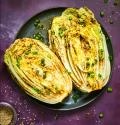With the arrival of autumn and winter, the perfect season for stewing Chinese cabbage has also arrived. Chinese cabbage is a cruciferous vegetable with slightly thick, white stems that are rich in water. Whether used in soups or stir-fries, Chinese cabbage creates a sweet and refreshing flavor.
Chinese cabbage is mainly divided into three types: Chinese cabbage, Shandong Chinese cabbage, and Tianjin Chinese cabbage. They differ slightly in appearance and cooking methods. Braised Chinese cabbage is sweet and warming. How should you choose Chinese cabbage? What are the key points to enhance the flavor of braised Chinese cabbage?
How should you choose Chinese cabbage?
Chinese cabbage is primarily cabbage, which refers to cabbage with leaves and stems that overlap to form a ball, like Chinese cabbage. Chinese cabbage is in season from November to April each year, and is also grown in cooler mountainous areas during the spring and summer.
Chinese cabbage is characterized by its leaves wrapped around stems, with the stems appearing slightly whitish and plump, while the leaves are a bluish-green hue. Chinese cabbage is actually divided into three varieties: Chinese cabbage (Bai Cai), Shandong Chinese cabbage, and Tianjin Chinese cabbage.
What are the differences between these three varieties of Chinese cabbage, and how can they be distinguished?
Chinese cabbage: Its head-shaped appearance is the most obvious.
Chinese cabbage is the most common type of cabbage and is most easily distinguished by its head-shaped appearance. Its numerous stems and abundant moisture content give it a crisp texture, making it a popular choice for stir-frying to enjoy its sweet and fresh flavor.
Shandong Chinese cabbage: Its large size makes it best for making kimchi.
When you think of Shandong cabbage, you think of kimchi. Shandong cabbage, with its large, long, oval shape, is the most commonly used variety for making kimchi. Its long stems make it a good choice for soups and pot dishes, making it a good choice.
Tianjin Cabbage (Jade Cabbage): Long Strips, Suitable for Stir-frying
Tianjin cabbage, with its long strips, is smaller than Shandong cabbage and has thinner stems and leaves, making it suitable for stir-frying and soups. It is also often processed into pickled winter vegetables. After washing, drying, and dehydrating, the cabbage is cut into small pieces and pickled with salt, garlic, and other ingredients, creating a dish similar to dried cabbage.
Chinese Cabbage: A member of the cruciferous family, a good food for cell protection
Chinese cabbage is low in calories and rich in water, making it suitable for the general population and even recommended for those trying to lose weight. It contains antioxidant vitamin C, which aids in cell formation and maintenance. It also contains lutein and zeaxanthin, which have eye-protecting properties.
It is high in potassium, a mineral that also contains calcium and phosphorus, essential for bone and tooth formation. Magnesium stabilizes and maintains cell function and nerve transmission. Chinese cabbage belongs to the cruciferous family. Like broccoli and cabbage, it contains compounds such as indole-3-carbinol and sulfur-containing compounds such as isothiocyanates, which help fight harmful cells or substances.
For braised Chinese cabbage, choose cabbage with plump and dense stems and leaves.
This is a must-have ingredient.
Making Chinese cabbage with braised cabbage is a must-have dish for fall and winter. To prepare braised Chinese cabbage, choose the right type: one with tightly packed stems and leaves, a heavy feel when handling, and plump, juicy stems and leaves.
Also, check for any yellowing or disease or pest infestation. As for the secret to braised Chinese cabbage, the sun-dried dried shrimp, dried shiitake mushrooms, and dried flatfish are the key to creating a rich flavor. Don’t forget to use garlic, shallots, and other spices.
Add the spices in order, stir-frying until the aroma is layered. Then add the cabbage and stir-fry. Remember to use the water from soaking mushrooms, chicken bones, or other broth for the simmering water. Season with a moderate amount of salt for a delicious, sweet braised cabbage.
For a more luxurious braised cabbage recipe, we recommend ingredients like fried pork skin, dried scallops, and egg custard to elevate your taste.


Leave a Reply